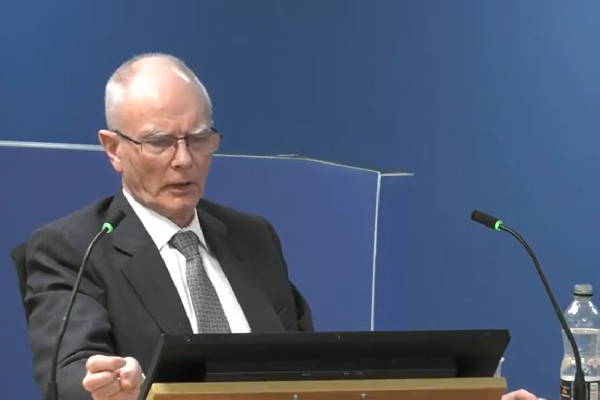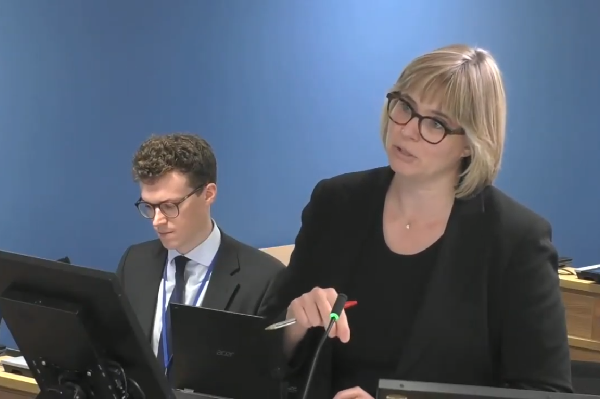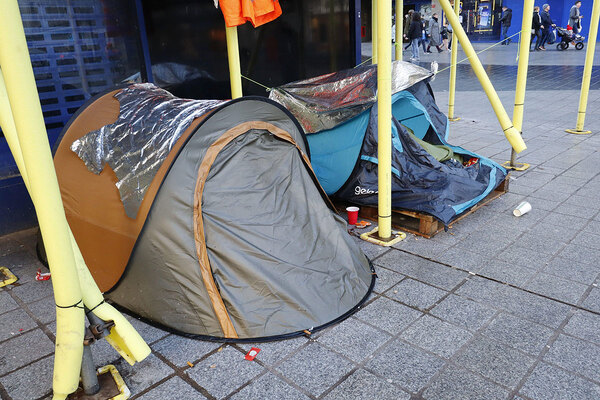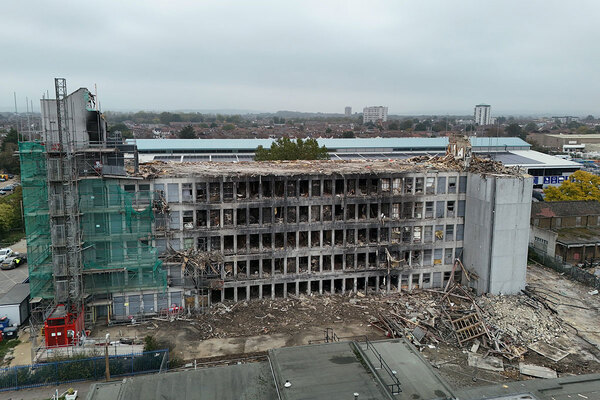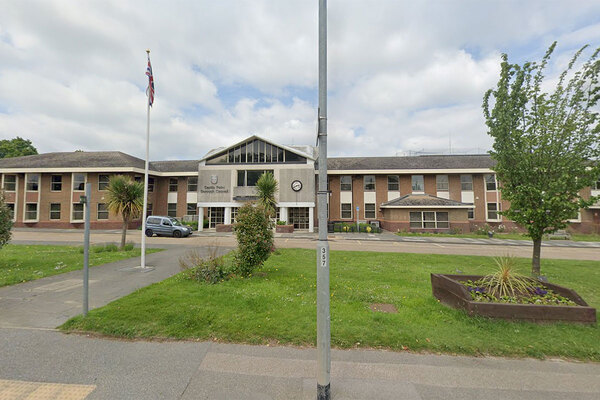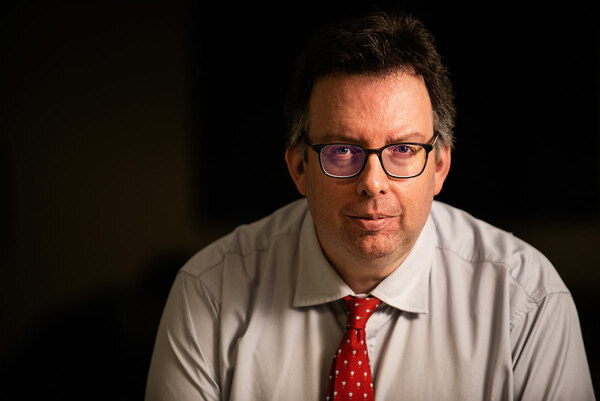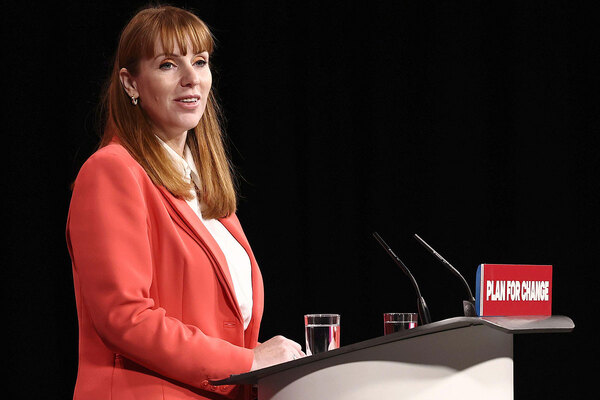Grenfell Tower Inquiry diary week 59: ‘Recent tests have apparently shown it continued to burn for 20 minutes after a flame was taken away’
After shocking opening statements, the Grenfell Tower Inquiry turned its attention to the work of Local Authority Building Control (LABC). Peter Apps reports
This week began with shocking opening statements from lawyers for the bereaved and survivors, who branded the Grenfell Tower fire “one of the major scandals of our time” and accused the government of a “prolonged period of concealment” concerning the risks of dangerous cladding.
We have already summarised what they said here and reported on the partial apology issued by the government’s lawyer here.
We will now turn to the evidence that also began this week, mostly concerning a body called Local Authority Building Control (LABC) and a series of certificates it provided for Kingspan’s K15 insulation. Not for the first time, it is necessary to begin with some explanation.
What is the significance of the LABC certificate?
LABC is a membership organisation for building control inspectors at local councils. This means its views are important and influential in persuading inspectors to accept certain construction products as compliant.
The organisation monetised this influence by selling certificates to product manufacturers. These assured building control inspectors that the product was suitable.
LABC provided certificates for both types of insulation used on Grenfell: Celotex RS5000 and Kingspan K15. Both were combustible and neither should have been used on a high-rise outside of a system that had passed a large-scale test.
This week we have been hearing about the certificate for Kingspan’s K15, first issued in 2009, with a further ‘registered detail’ document published in 2014.
As the inquiry has already heard, this certificate said the insulation “can be considered a material of limited combustibility” and was therefore “suitable for use” on high-rise buildings.
These statements were wrong and both Kingspan and LABC witnesses have accepted they were misleading.
We have already heard from David Jones (pictured above), the inspector who wrote the certificate. He says he was “misled” by Kingspan and “pressured” by LABC into producing it.
We have also seen Kingspan emails, where employees wrote: “We can be very convincing when we need to be, we threw every bit of fire test data we could at him, we probably blocked his server.
“In the end I think LABC convinced themselves [K15] is the best thing since sliced bread. We didn’t even have to get any real ale down him!”
This week we looked into the internal processes at LABC that allowed the certificate to be published and never corrected.
‘It’s a pretty major [error] to describe it as a material that can be considered a material of limited combustibility when there is absolutely no test evidence to support that’
After the certificate was drafted by a council inspector in Herefordshire, it should have undergone a process of peer review. LABC’s process was to consult 12 reviewers. Once four approved it, the document went through.
The K15 certificate was sent out to a group of reviewers on 3 March 2009. Two reviewers responded, questioning: “Why is an insulation board a system?”
This was a pertinent question. The testing showed Kingspan had only approved its product for use on high-rises as part of one specific cladding system, but the LABC certificate was effectively clearing it for general use in all systems.
“They’re raising that very clearly, aren’t they?” asked Kate Grange QC.
Barry Turner, former director of technical policy at LABC, said he believed the question was in relation to the product’s thermal performance as opposed to fire safety.
It does not appear anyone responded to the reviewer’s concerns. In April, another LABC staff member asked when the certificate would be published, noting “pressure from Kingspan”.
The certificate was ultimately issued, unamended, with the erroneous description still included.
Asked about a similar review process for the 2013 certificate, the week’s second witness, David Ewing (pictured above), head of education at LABC, was asked: “Can we agree that it’s concerning that those involved in this peer-review process were not able to identify the technically incorrect information provided?”
“I think you can, yes,” he said.
“It’s a pretty major [error] to describe it as a material that can be considered a material of limited combustibility when there is absolutely no test evidence to support that; can we agree that?” asked Ms Grange.
“Yes,” he replied.
‘Did you appreciate the public safety ramifications of being so dismissive to Rockwool’s concerns?’
Not long after the certificate was published, LABC received a warning that it might not be accurate.
In September 2009, Rockwool, a rival of Kingspan that produces mineral-wool insulation, wrote to Mr Turner to query the claims Kingspan was making about the certificate.
The letter called the claims “of serious concern” and spelled out why K15 was not of limited combustibility or suitable for high-rises in most circumstances.
The letter was cc-ed to Brian Martin, a senior government official responsible for building guidance.
What was Mr Turner’s (pictured above) response? “From recollection, I didn’t consider them [the complaints]. My recollection is that this was considered a complaint from a competitor, and LABC shouldn’t act as referee between competitors.
“I put my trust in those that had dealt with the matter and the certifications that were in place by [other organisations], rather than believe an argument put forward by a competitor.”
He said the fact that Mr Martin “was copied in and [had] not responded diminished the strength of the letter”.
Rockwool wrote again a month later, chasing a response and adding that the claims were “extremely important with respect to both life safety and property protection”.
LABC still did not respond. Rockwool continued to chase, with an email in February 2010.
We then saw that Mr Turner emailed Kingspan’s head of marketing to discuss it – someone he said he knew “very well”.
Mr Turner said he would “look at the issue more closely” and asked Kingspan “not to circulate the original Rockwool letter”.
“Can you explain why you were discussing this with the head of marketing at Kingspan before you’ve even investigated the substance of the complaint?” asked Ms Grange.
“I think the first connection or the first correspondence came from them [Kingspan], not from me,” replied Mr Turner.
He eventually replied to Rockwool on 23 February 2010, writing that “the local authority, that carried out the assessment… were satisfied that it met the relevant criteria”, adding “it is not for us to explain to third parties our reasons or justifications”.
“Did you appreciate the public safety ramifications of being so dismissive to Rockwool’s concerns?” asked Ms Grange.
“If I had appreciated that I wouldn’t have dealt with it in the way that I did,” said Mr Turner.
‘Did that sponsorship involvement with Kingspan impact on the LABC’s decision to investigate the concerns?’
At around the same time, LABC had several other business dealings with Kingspan.
First, it was relying on the manufacturer for advice about industry guidance it was producing for its members. In one instance it even allowed the firm to include its logo on the guidance document.
This prompted a complaint from another organisation, which wrote in February 2009: “Surely LABC have to be neutral and be seen to be neutral… This kind of sponsorship is not something we’ve ever seen before.”
The email suggested using trade body groups for advice rather than a single manufacturer. Mr Turner did not respond until December, when he promised to “take your concerns into account”.
But further documents showed LABC continued to liaise with Kingspan directly about its guidance.
The firm also sought a commercial sponsorship deal from Kingspan, where the firm would pay £12,500 to sponsor its awards. LABC promised it would receive “direct outreach” to 4,000 surveyors and 3,000 special customers, which would “provide an indirect route to sales through referrals”.
“Were you ever involved in any discussion about whether such business sponsorship packages risked prejudicing LABC’s independence from manufacturers?” asked Ms Grange (pictured above).
“It was a difficult line for us to follow… because we had a need for income to be able to promote local authority building control in a competitive market,” said Mr Taylor.
“Did that sponsorship involvement with Kingspan impact on the LABC’s decision to investigate the concerns which had been raised by third parties about the K15 certificates?” asked Ms Grange.
“No, because I didn’t tie the two together. I was not involved in this discussion or this sponsorship discussion,” said Mr Turner.
‘Recent fire tests have apparently shown it continued to burn for 20 minutes after a flame was taken away’
The warnings from Rockwool were not the only ones LABC received suggesting that its certificate for K15 was misleading.
In 2013, the firm provided Kingspan with a series of ‘registered detail’ certificates for their products, including one for K15. This repeated the misleading claims from the 2009 certificate.
It also included an appendix which re-emphasised the suitability of the insulation for high-rises and included two diagrams showing its potential use.
This appendix and the diagram were copied and pasted directly from an email sent by Kingspan. The diagrams showed systems in which the product had never been tested successfully.
Around this time – as the inquiry heard previously – the National House Building Council (NHBC), a large private building-control body, was raising concerns separately with Kingspan about the suitability of its insulation for high-rises.
The NHBC emailed LABC to warn it about the concerns.
In October 2014, Mr Ewing emailed Mr Turner to say the NHBC was concerned “K15 has been used outside the scope of installation” and “recent fire tests have apparently shown it continued to burn for 20 minutes after a flame was taken away”.
Mr Turner responded by saying he would join a call with NHBC about the issue, but was “not going to say or admit to anything at this stage”.
“Do you recall that discussion you had [with the NHBC]?” asked Ms Grange.
“I don’t recall that conversation or whether it took place,” said Mr Turner.
Another LABC colleague emailed in December 2014, referring to a meeting where the “sales director of Kingspan was very bullish”, but wrote there was “no likelihood of Kingspan coming up with tests that prove it works in high-risk constructions”.
“Did you think, at that point, about issuing a warning to your members to say, well, there’s a problem here, we’ve been issuing certificates for many years now for the K15 product and those certificates have inaccurate information on them?” asked Ms Grange.
“I left it to the others that were dealing with the matter… to follow that up,” said Mr Turner.
The inquiry saw that he ultimately suggested amending the K15 certificate so that it continued to say the product was suitable “for use in rainscreen [cladding] applications above 18 metres in height”, but merely added the words “however, see scope and conditions of certificate for more information”.
“You see the problem with that statement, that you’re suggesting that it’s inferring global approval for use of K15 in rainscreen applications over 18 metres in height, whereas it should have said the K15 complies… only when used in one specific system configuration,” said Ms Grange.
“With hindsight and with legal appraisal of it, I would not disagree,” said Mr Turner. “That was my wording. If my wording was not correct, and you challenge that now, I would accept that. But it was not done with legal implications in mind.”
He went on to assure others within the business that the issue was “an insurance issue, not one of regulatory compliance”. He said he could not recall why he had said this.
When the issue was raised again in January 2015, one of his colleagues, Lorna Stimpson, wrote: “This issue has been burning for a LONG time though, hasn’t it? (Get it !!!!) Why is it raising its head again all of a sudden?”
Ms Stimpson is the current chief executive of LABC. Since the fire, Mr Turner has chaired a policy group which has aimed to review how large-scale testing of cladding systems operate.
‘Identifying possible solutions to allowing polyurethane-type insulation materials to be used in cladding systems over 18m’
One final issue from this week’s evidence is worth noting. In July 2014, an organisation called the Building Control Alliance (BCA) published a technical guidance note which said untested cladding systems could be used so long as they were approved by an accredited laboratory through a desktop study.
We saw this week that both the NHBC and LABC were involved in drafting this document. In one meeting, Steve Evans of the NHBC is recorded as saying the purpose was “identifying possible solutions to allowing polyurethane-type insulation materials to be used in cladding systems over 18m”.
When the guidance was widened in 2015 to permit any competent professional to carry out the assessments, internal Kingspan emails suggested this was “incorporating some of the changes that we had asked for”.
The inquiry was then shown emails exchanged between BCA members 10 days after the Grenfell Tower fire, discussing whether the guidance note should be withdrawn.
Mr Evans said doing so would be “a serious overreaction” and “will not only leave a lot of schemes already under construction in jeopardy but will also cause issues with the completed schemes where builders have used the note to demonstrate compliance”.
In the same email chain, Mr Turner said withdrawing the guidance would “leave BCA with egg on its face” and suggested “a review” before any decision was made about whether to withdraw it.
The inquiry continues, with Mr Ewing continuing next week.
Grenfell Tower Inquiry phase two: weekly diaries
Module one: the refurbishment
Week one: A vivid picture of a broken industry
After a week of damning revelations at the opening of phase two of the Grenfell Tower Inquiry, Peter Apps recaps the key points
Click here to read the full story
Week two: What is the significance of the immunity application?
Sir Martin Moore-Bick has written to the attorney general requesting protection for those set to give evidence at the Grenfell Tower Inquiry. Peter Apps explains what the move means
Click here to read the full story
Week three: Architects of misfortune
This week saw the lead architects for the Grenfell Tower refurbishment give evidence to the inquiry. Peter Apps runs through the key points
Click here to read the full story
Week four: ‘I didn’t have any perception that it was the monster it’s become’
The architects continued to give evidence this week, outlining a lack of understanding of the fire risk posed by the cladding materials and its design. Nathaniel Barker reports
Click here to read the full story
Week five: ‘No adverse effect in relation to external fire spread’
As the Grenfell Tower Inquiry returns from its long absence, Peter Apps recaps the key points from a week of important evidence from the fire consultants to the refurbishment
Click here to read the full story
Week six: ‘I can’t recall any instance where I discussed the materials with building control’
Nathaniel Barker summarises what we learned from fire engineers Exova, architects Studio E and the early evidence from contractor Rydon
Click here to read the full story
Week seven: ‘I do not think I have ever worked with a contractor operating with this level of nonchalance’
Two key witnesses from contractor Rydon gave evidence this week. Peter Apps recaps some of the key points from a revealing week of evidence
Click here to read the full story
Week eight: ‘It haunts me that it wasn't challenged’
Four witnesses from contractor Rydon gave evidence this week. Lucie Heath recaps what we learned on the last week of evidence before the inquiry breaks for five weeks
Click here to read the full story
Week nine: ‘All I can say is you will be taken out for a very nice meal very soon’
This week the inquiry heard evidence from witnesses at Harley Facades, the sub-contractor responsible for Grenfell Tower’s cladding. Peter Apps recaps the key points
Click here to read the full story
Week 10: ‘As we all know, ACM will be gone rather quickly in a fire!’
As the Grenfell Tower Inquiry entered its 10th week, Jack Simpson recaps the key points from a week of important evidence from the refurbishment’s cladding contractor
Click here to read the full story
Week 11: ‘Did you get the impression Grenfell Tower was a guinea pig for this insulation?’
With witnesses from the cladding subcontractor, the firm which cut the deadly panels to shape and the clerk of works which inspected the job giving evidence this was week full of revelations. Peter Apps recaps the key points
Click here to read the full story
Week 12: ‘Would you accept that was a serious failing on your part?’
With the surveyor who inspected Grenfell Tower for compliance giving evidence, this was a crucial week from the inquiry. Dominic Brady and Peter Apps report
Click here to read the full story
Week 13: ‘Value for money is to be regarded as the key driver for this project’
With consultants to Kensington & Chelsea Tenant Management Organisation (KCTMO) giving evidence, attention at the Grenfell Tower Inquiry turned for this first time to the actions of the TMO and the council. Peter Apps reports
Click here to read the full story
Week 14: ‘Did it not occur to you at this point that your budget was simply too low?’
This week, for the first time in phase two, the inquiry heard from Kensington & Chelsea Tenant Management Organisation, the landlord that oversaw the fatal refurbishment of Grenfell Tower. Lucie Heath reports
Click here to read the full story
Week 15: ‘Have you ever informed the police that you destroyed documents relevant to their investigation?’
Witnesses from the Kensington and Chelsea Tenant Management Organisation (KCTMO) gave evidence for a second week, which began with a shocking revelation about withheld and destroyed evidence. Peter Apps recaps
Click here to read the full story
Week 16: ‘I conclude this was very serious evidence of professional negligence’
This week saw members of Kensington & Chelsea Tenant Management Organisation finish giving evidence, before the inquiry’s expert witnesses took the stand to make some highly critical assessments of the work they had seen before and during the refurbishment of Grenfell Tower. Jack Simpson recaps
Click here to read the full story
Grenfell Tower: a timeline of the refurbishment
Following the conclusion of module one of the Grenfell Inquiry’s second phase, Peter Apps presents a timeline of the key moments during the fatal refurbishment of the west London tower block
Click here to read the full story
Module two: the cladding products
Week 17: ‘It’s hard to make a note about this because we are not clean’
The start of the second module of the Grenfell Tower Inquiry phase two came with some huge revelations about the companies that sold the products used in the cladding system. Peter Apps reports
Click here to read the full story
Week 18: ‘It was just reckless optimism wasn't it?’
As the inquiry began cross-examining witnesses for the second module of its phase two work, the picture surrounding just how Grenfell Tower ended up wrapped in such dangerous materials became a little clearer. Nathaniel Barker was keeping an eye on proceedings
Click here to read the full story
Week 19: ‘And that was intentional, deliberate, dishonest?’
The Grenfell Tower Inquiry this week heard the shocking story of how the insulation manufacturer “manipulated” official testing and marketed its product “dishonestly”. Peter Apps tells the story
Click here to read the full story
Week 20: ‘We were outed by a consultant who we then had to fabricate a story to’
This week the inquiry investigated the actions of Kingspan – the manufacturer of one of the insulation products used in the tower’s cladding system. Dominic Brady reports
Click here to read the full story
Week 21: ‘It’s there in black and white isn't it? We see a complete absence of any consideration of life safety’
The story of insulation giant Kingspan’s testing and marketing of its combustible insulation for high rises was unpacked in minute detail this week. Peter Apps reports
Click here to read the full story
Week 22: ‘All we do is lie in here’
In the third week of evidence from insulation giant Kingspan, the inquiry continued to uncover shocking details about the firm’s behaviour both before and after the Grenfell Tower fire. Lucie Heath reports
Click here to read the full story
Week 23: ‘That would have come as an earthquake to you at the time, would it not?’
This week the inquiry took its deepest dive yet into the inner workings of the cladding manufacturer whose product has been blamed for the terrible spread of fire up Grenfell Tower. Nathaniel Barker reports
Click here to read the full story
Week 24: ‘Do you accept that Test 5B was Arconic's deadly secret’
The president of the firm that made and sold the cladding panels installed on Grenfell Tower was asked to account for the apparent concealment of “disastrous” fire tests on the product this week. Peter Apps reports
Click here to read the full story
Week 25: ‘This is quite an incredible list of omissions and missed instances, isn’t it?’
This week the Grenfell Tower Inquiry heard its first witnesses from the Building Research Establishment (BRE) - the testing house which carried out key fire tests on the Kingspan and Celotex insulation products which were later used on Grenfell Tower. Peter Apps reports.
Click here to read the full story
Week 26: 'You were taking an enormous risk, weren't you?'
Week 26 at the Grenfell Tower Inquiry was a key moment in understanding how dangerous products used on the tower came to be accepted by industry professionals. Dominic Brady reports
Click here to read the full story
Week 27: ‘What will happen if one building made out [of] PE core is in fire and will kill 60 to 70 persons?’
The most explosive evidence this week at the Grenfell Tower Inquiry came from those who did not attend, as the evidence which would have been presented to Arconic witnesses was displayed in their absence. Peter Apps reports
Click here to read the full story
Week 28: ‘This is a serious safety matter’
This week the Grenfell Tower Inquiry zeroed in on the British Board of Agrément, the body that produced “misleading” certificates which inspired trust in both the cladding and insulation used on the tower. Lucie Heath reports
Click here to read the full story
Week 29: ‘Is it true that Kingspan’s position… was to do its best to ensure that science was secretly perverted for financial gain?’
The final week in this section of the Grenfell Tower Inquiry primarily examined the attempts by insulation manufacturer Kingspan to lobby government after the fire. Peter Apps reports
Click here to read the full story
How the products used in Grenfell Tower's cladding system were tested and sold
As the section of the Grenfell Tower Inquiry examining how the products used in the cladding system were tested, marketed and sold comes to a close, Peter Apps summarises what we have learned about each of the products included in the system
Click here to read the full story
Module Three: the management of the tower
Week 30: ‘There is certainly a high probability that in the event of a fire the whole building can become an inferno’
The focus of the inquiry shifted this week to the actions of the social housing providers responsible for maintaining Grenfell Tower. Pete Apps recaps what we learned
Click here to read the full story
Week 31: ‘If we cannot get out people will die’
This week saw the former residents of Grenfell Tower enter the witness box to tell of their experiences attempting to raise complaints with the council and its managing agent. Pete Apps reports
Click here to read the full story
Week 32: ‘Let's hope our luck holds and there isn't a fire’
This week saw the return of the landlord of Grenfell Tower, Kensington and Chelsea Tenant Management Organisation (KCTMO), as senior staff members attempted to explain how vital fire safety protections at the block were allowed to fall into disrepair. Lucie Heath reports
Click here to read the full story
Week 33: ‘Isn't that a serious gap in the scope of a policy meant to safeguard vulnerable people?’
A slightly disjointed week at the Grenfell Tower inquiry saw further evidence from staff at building manager Kensington and Chelsea Tenant Management Organisation (KCTMO) interspersed with the views of a cladding expert. Peter Apps reports
Click here to read the full story
Week 34: ‘Some members of the community are doing their best to spread false information’
Jack Simpson covers all the major revelations from the past week of evidence at the Grenfell Inquiry, including evidence from Laura Johnson, director of housing at the Royal Borough of Kensington and Chelsea.
Click here to read the full story
Week 35: ‘I really didn’t like the champagne’
This week the Grenfell Tower Inquiry saw council witnesses, including former deputy leader Rock Feilding-Mellen and leader Nicholas Paget-Brown, questioned about their role in the story for the first time. Peter Apps reports
Click here to read the full story
Week 36: ‘Is that not a very incurious approach for a fire risk assessor?’
This week the Grenfell Tower Inquiry scrutinised the work of Carl Stokes, the man hired to carry out fire risk assessments for the block. Nathaniel Barker reports
Click here to read the full story
Week 37: ‘In giving that advice, weren’t you acting beyond your knowledge and expertise?’
A curtailed week at the Grenfell Tower Inquiry saw fire risk assessor Carl Stokes grilled over advice he gave regarding the tower’s cladding. Peter Apps reports
Click here to read the full story
Week 38: ‘Well it’s a bit more than that, isn’t it. He’s suggesting that you tell the LFB a lie’
The inquiry heard the mammoth cross-examination of KCTMO’s health and safety manager Janice Wray this week. Peter Apps reports
Click here to read the full story
Week 39: ‘What you said there was a grotesque understatement’
This week the inquiry continued to hear from former employees of Kensington and Chelsea Tenant Management Organisation, as well as two employees from the London Fire Brigade. Lucie Heath reports
Click here to read the full story
Week 40: ‘An exercise in concealment and half-truth’
Former KCTMO chief executive Robert Black gave his evidence to the inquiry this week and was asked to account for the various failures described over the previous six weeks. Peter Apps and Nathaniel Barker report.
Click here to read the full story
Week 41: ‘We should do nothing. This is not the sort of website we should be responding to’
This week saw the return of Robert Black, chief executive of Kensington and Chelsea Tenant Management Organisation (KCTMO), before the inquiry turned its attention to the defective smoke control system in the tower. Dominic Brady reports
Click here to read the full story
Week 42:‘They would leak as much as they leaked. They were what they were’
The Grenfell Tower Inquiry continued its in-depth investigation of the tower’s non-compliant smoke control system this week, with evidence from the various contractors involved in delivering it. Pete Apps reports
Click here to read the full story
Week 43:‘Contractors at the time were not generally aware of the importance of leaving holes unsealed’
This week the inquiry focused on two of the more overlooked areas of the Grenfell Tower fire, with evidence focusing on the gas pipelines and lifts within the west London block. It was a packed week, with five witnesses giving evidence. Jack Simpson reports
Click here to read the full story
Week 44:‘I've never seen a fully compliant firefighting lift in any local authority building, to this day actually’
This week the inquiry turn the focus onto the building’s defective lifts, with evidence from an expert, contractors who worked on them and a former engineer at KCTMO. Pete Apps reports.
Click here to read the full story
Week 45: ‘Don’t you find all this rather a surprising debate, given that the Equality Act was passed in 2010?’
The inquiry heard from expert witness Colin Todd this week, who gave his views about the work of risk assessor Carl Stokes as well as answered questions about his own guidance. Peter Apps and Nathaniel Barker report
Click here to read the full story
Week 46: ‘I think I've been very, very clear that is completely wrong’
This week the inquiry heard further expert evidence about fire risk assessor Carl Stokes’ actions, as the section of its work covering the management and maintenance of the tower concluded. Peter Apps reports
Click here to read the full story
Six key failures in the way Grenfell Tower was managed before the fire
Peter Apps recaps some of what we have learned about the actions of the Royal Borough of Kensington and Chelsea (RBKC) and Kensington and Chelsea Tenant Management Organisation (KCTMO) in the years before the fire.
Module one and two closing statements
Week 47: ‘An unedifying spectacle’
After a week of closing statements from the core participants involved in modules one and two, Lucie Heath recaps the key arguments of each group
Click here to read the full story
Module five: the fire brigade
Week 48: ‘They knew, and lives could and should have been saved’
The phase of the Grenfell Tower Inquiry examining the actions of the London Fire Brigade in the years before the fire kicked off this week with some major revelations. Peter Apps reports
Click here to read the full story
Week 49: ‘I'm not sure we've always taken every opportunity to learn as an organisation’
How the London Fire Brigade acted upon lessons from incidents in the years before the Grenfell Tower disaster came under the microscope this week at the public inquiry. Nathaniel Barker reports
Click here to read the full story
Week 50: ‘There is a culture in LFB that is very conservative. I think there is great comfort in what is familiar’
This week the inquiry heard how the London Fire Brigade (LFB) elected not to issue warnings about dangerous cladding before Grenfell and a detailed examination of its policy for checking high risk buildings. Pete Apps reports.
Click here to read the full story
Week 51:‘We teach firefighters to expect building failure’
An unusually brief week of evidence at the Grenfell Tower Inquiry explored how a fire service neighbouring London was taking a different approach to tackling blazes in high rises. Nathaniel Barker reports
Click here to read the full story
Week 52: ‘I actually think that there is a measure of incompetence at all levels’
Expert evidence concluded the current section of the inquiry with some stinging criticism of the London Fire Brigade (LFB). Pete Apps and Grainne Cuffe report.
Click here to read the full story
Module six: fire services
Week 53: ‘They make for chilling reading and harrowing listening’
The inquiry’s investigation into central government began this week with lawyers setting out their view on how and why firefighting policies failed. Peter Apps and Lucie Heath report
Click here to read the full story
Week 54: ‘Our consideration of evacuation at this time was something of a blind spot’
The development of policy on ‘stay put’, both nationally and for London, occupied the attention of the inquiry this week. Peter Apps reports
Click here to read the full story
Week 55: ‘My review is pretty scathing!’
In a week that included the 200th day of evidence in phase two of the inquiry, attention turned to the London Fire Brigade’s control room. Lucie Heath reports
Click here to read the full story
Week 56: ‘Why didn't we thump the table harder’
This week, the control room at the London Fire Brigade was examined further – both before and after the fire. Pete Apps and Lucie Heath report
Click here to read the full story
Week 57: ‘It was worse than slow, it was sluggish’
Former London Fire Brigade (LFB) commissioner Dany Cotton was the star witness this week, as the inquiry continued to delve into the brigade’s knowledge and training before the Grenfell Tower fire. Jack Simpson, Grainne Cuffe and Pete Apps report
Click here to read the full story
Week 58: ‘I don't think we deserve to ask for trust until we demonstrate different outcomes’
A current and former commissioner of the London Fire Brigade (LFB) wrapped up the inquiry’s investigation into the actions of the brigade before the fire. Grainne Cuffe and Peter Apps report.
Module six: testing and government
One of the major scandals of our time: key revelations as the Grenfell Tower Inquiry turns to government
The government was accused of “covering up” the risks of dangerous cladding as its “unbridled passion for deregulation” left it a “junior party” to the construction industry as the latest phase of the public inquiry opened today. Peter Apps summarises some of the main points
Click here to read the full story
Week 59: ‘Recent tests have apparently shown it continued to burn for 20 minutes after the flame was taken away’
After shocking opening statements, the Grenfell Tower Inquiry turned its attention to the work of Local Authority Building Control. Pete Apps reports
Click here to read the full story
Week 60: ‘You could have an exact repeat of the Dubai fire in any number of buildings in London’
The Grenfell Tower Inquiry turned its attention to the work of the National House Building Council this week, with shocking revelations about the extent of the warnings issued to central government before the fire. Peter Apps reports
Click here to read the full story
Week 61: ‘Mistakes are meant for learning, not repeating’
In the first hearings of the new year, the Grenfell Tower Inquiry heard closing statements from the firefighting section of phase two. Lucie Heath reports
Click here to read the full story
Week 62: Did it ever occur to you that this act of collaboration was, in one sense, corrupting?
The Grenfell Tower Inquiry returned to the work of the National House Building Council (NHBC) this week, with a new shocking revelation about the government’s actions in the immediate aftermath of the fire. Peter Apps reports
Click here to read the full story
Week 63: ‘It came after the general move to deregulation. So more regulation was not welcome’
The government’s focus on deregulation before the Grenfell Tower fire was placed in the spotlight this week with a series of shocking revelations about its failure to amend fire safety guidance. Pete Apps and Grainne Cuffe report
Click here to read the full story
Week 64: ‘I didn’t think ACM would be suitable for use in any high-rise buildings. I don’t think anyone did’
This week, the Building Research Establishment’s Dr Sarah Colwell gave more than three days of evidence, with some huge revelations about what was known about the dangers of aluminium composite material years before the fire and the mass confusion over the government’s building regulations. Peter Apps and Jack Simpson report
Click here to read the full story
Week 65: ‘Unless the government does something now about ACM panels, people will die’
Further evidence from the Building Research Establishment and the first government witnesses added new depth to our understanding of how warnings were missed before the Grenfell Tower fire. Peter Apps reports
Click here to read the full story
Week 66: ‘Was there a cover-up?’
The latest evidence from the Grenfell Tower Inquiry tracked the government’s failure to act on fire safety warnings right up until the months before the fire. Peter Apps and Grainne Cuffe report
Click here to read the full story
Week 67: ‘When exposed to a fire, the aluminium melts away and exposes the polyethylene. Whoosh!’
This week the inquiry heard disturbing new evidence about the failure of senior government officials to act on warnings about dangerous cladding in the years before the Grenfell Tower fire. Peter Apps reports
Click here to read the full story
Week 68: ‘Can we agree that was a pretty dangerous thing to have, all this falling on one man’s shoulders?’
Three senior civil servants gave evidence this week, including the official who had responsibility for building regulations guidance on fire safety in the years before Grenfell. Peter Apps, Lucie Heath, Stephen Delahunty and Grainne Cuffe report
Click here to read the full story
Week 69: ‘It was just unthinkable. You had the makings here of a crisis you could not comprehend’
This week, civil servant Brian Martin gave his long-awaited evidence to the Grenfell Tower Inquiry. Peter Apps reports
Click here to read the full story
Week 70: ‘Show me the bodies’
An important week at the Grenfell Tower Inquiry saw a dramatic conclusion to the mammoth cross-examination of civil servant Brian Martin, as well as the first politicians. Peter Apps and Lucie Heath report
Click here to read the full story
Week 71: ‘I have changed my schedule to fit this in. I do have an extremely busy day meeting people’
Three politicians who were responsible for building regulations before Grenfell appeared before the inquiry this week, including the former communities secretary Eric Pickles, who responded to the coroner’s letter following the Lakanal House fire. Peter Apps and Lucie Heath report
Click here to read the full story
Module Four: aftermath
Week 72: 'The system isn't broken. It was built this way'
This week the inquiry turned to the shocking story of the lack of support for bereaved and survivors in the immediate aftermath of the Grenfell Tower fire. Peter Apps, Lucie Heath, Grainne Cuffe and Jack Simpson report
Click here to read the full story
Week 73: ‘Most people would regard that as hopeless’
This week, the Grenfell Tower Inquiry heard about the Royal Borough of Kensington and Chelsea’s chaotic response in the immediate aftermath of the blaze, from the staff responsible for it. Pete Apps, Stephen Delahunty and Grainne Cuffe report
Click here to read the full story
Week 74: ‘Do you agree that RBKC was ill-prepared and incapable to meet its duties’
This week, Nicholas Holgate, former chief executive of the Royal Borough of Kensington and Chelsea, was grilled on his failure to hand over control of the aftermath of the fire, despite the borough’s lack of capacity. Peter Apps reports
Click here to read the full story
Week 75: ‘It still shocks me to the core that that’s how we treat our citizens in this country’
This week the inquiry heard witnesses from the housing management body discuss their role in the aftermath of the Grenfell Tower fire, followed by a range of witnesses from other organisations which supported the response. Peter Apps and Grainne Cuffe report
Click here to read the full story
Week 76: ‘I fear this will become our New Orleans’
This week the inquiry heard from central government figures and members of the London-wide emergency response arrangements. Peter Apps and Grainne Cuffe report
Click here to read the full story
Week 77: ‘The planning wasn’t done and there was nothing for us to be drawing on’
The Grenfell Tower Inquiry’s examination of the aftermath of the fire concluded with witnesses from central government. Peter Apps reports
Click here to read the full story
Module seven: expert evidence and closing statements
Week 78: ‘The abandonment of the ‘stay put’ strategy for high-rise residential buildings is essential’
This week the Grenfell Tower Inquiry heard a range of expert witnesses discuss their reports. Peter Apps and Grainne Cuffe report
Click here to read the full story
Week 79: ‘You could argue the system was created to enable people to circumvent the rules’
The Grenfell Tower Inquiry continued to hear expert evidence this week, with two senior figures in the world of fire safety academia criticising the government’s approach before and after the blaze. Peter Apps and Grainne Cuffe report
Click here to read the full story
Week 80: ‘The evidence points to wilful blindness and complacency towards safety’
As the inquiry moves into its final stages, lawyers for the key players gave statements about the evidence surrounding central government. Peter Apps reports
Click here to read the full story
Week 81: ‘This is Islamophobia. It’s racism. It is the elephant staring back at us in the room’
This week, closing statements covering the aftermath of the fire delivered a shocking new revelation and an expert toxicologist gave his views on the causes of the deaths. Peter Apps reports
Click here to read the full story
Module eight: further evidence relating to the deceased
Week 82: ‘Their chance to hear about the circumstances in which their loved ones died is the culmination of five years of waiting’
The Grenfell Tower Inquiry moved into its final module this week, with evidence relating to the circumstances in which the victims died. Peter Apps reports
Click here to read the full story
Week 83: ‘They died together as they lived: caring for one another’
A second week of evidence relating to the circumstances in which the victims of the fire died delivered more heartbreaking stories about their final moments. Peter Apps recaps
Click here to read the full story
Week 84: ‘Every decision affects someone who is an adored child, a beloved sister, a respected uncle, a needed mother’
The final week of oral evidence for the Grenfell Tower Inquiry’s second phase contained more heartbreaking evidence about the deaths in the tower. Peter Apps reports
Click here to read the full story
Closing statements
Week 85: ‘The merry-go-round turns still, the notes of its melody clearly audible in the last few days’
The Grenfell Tower Inquiry returned this week for closing statements from lawyers representing the bereaved and survivors and the various parties under scrutiny for the fire. Pete Apps reports.
Sign up for our weekly Grenfell Inquiry newsletter
Each week we send out a newsletter rounding up the key news from the Grenfell Inquiry, along with the headlines from the week
Already have an account? Click here to manage your newsletters

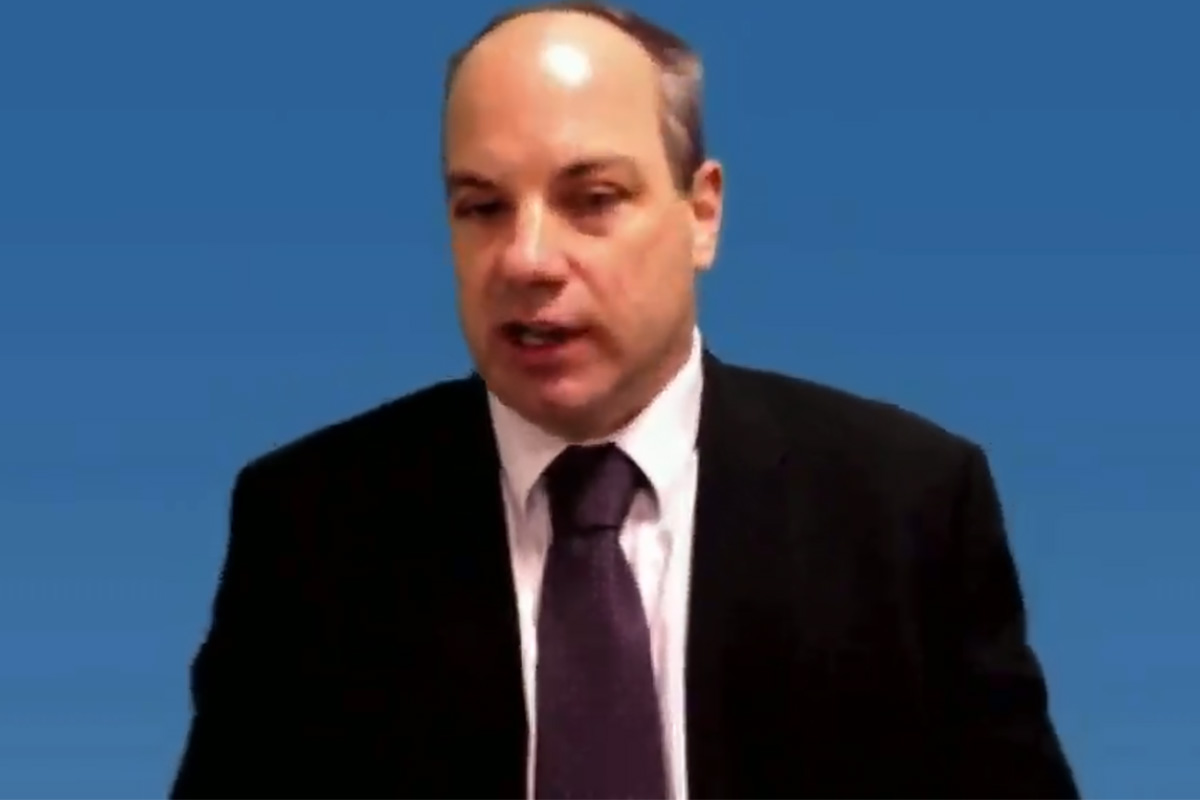
![‘It’s a pretty major [error] to describe it as a material that can be considered a material of limited combustibility when there is absolutely no test evidence to support that’ ‘It’s a pretty major [error] to describe it as a material that can be considered a material of limited combustibility when there is absolutely no test evidence to support that’](https://omghcontent.affino.com/AcuCustom/Sitename/DAM/175/ewing.png)
